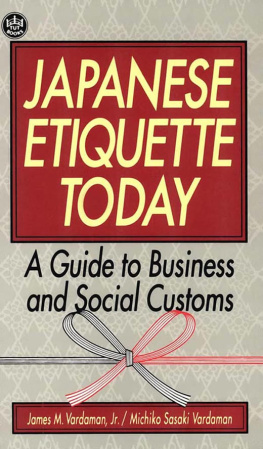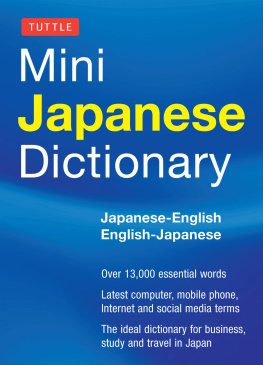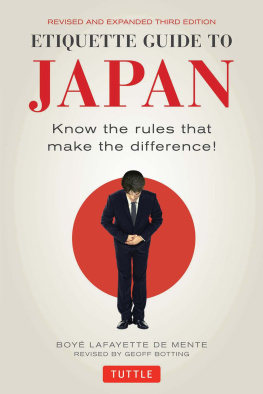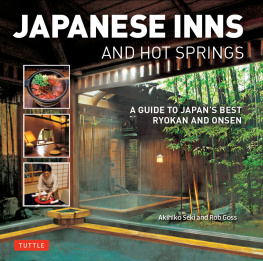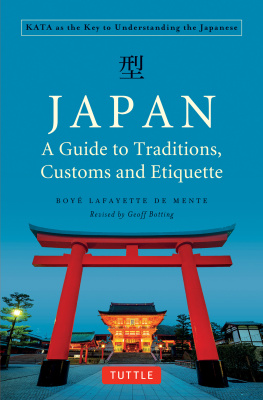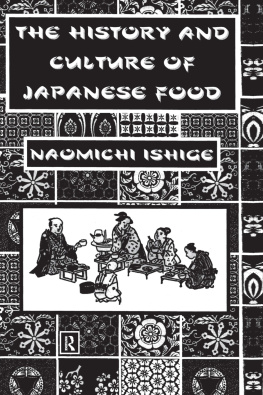~ ANNUAL EVENTS ~
January
JAPANESE FAMILIES usually spend January 1 (gantan) and the next two or three days reading New Year's greeting cards (nengaj), eating special New Year's dishes (o- sechi ryari), making first visits to shrines or temples (hatsumode), and entertaining a few guests and relatives in their homes. This period is an extended holiday for banks, public offices, and most companies. One makes formal first visits (nenshi-mawari) to superiors, usually taking a gift of food. The common greeting is Akemashite omedet gozaimasu. Kotoshi mo dozo yoroshiku o-negai shimasu.
The first day of work in the new year (shigoto hajime) varies from employer to employer, but generally falls on the sixth or seventh. One should ask beforehand when business resumes after the holidays. In large enterprises the first day of work is comprised of formal greetings and perhaps a short party, so real business resumes on the next weekday.
Adults' Day (seijin no hi), on the fifteenth, is a national holiday honoring the legal coming of age of young people who have reached twenty. Local governments hold ceremonies to recognize young people and private parties follow. Friends and relatives may present neckties, card cases, or accessories to men and necklaces, earrings, or other accessories to women.
February
February 14 is Valentine's Day, a day on which Japanese women give chocolate to the men in their lives. At their workplaces some female employees present giri-choko,"obligatory chocolate," to their supervisors and other male employees. There has not been such wide acceptance of the custom of men returning chocolate on "White Day," March 14.
March
The Dolls' Festival or Girls' Festival (hina matsuri) takes place on the third. It is essentially a family affair in which traditional dolls are displayed and special cakes and sweets are eaten by girls and their friends.
The latter half of March is graduation season. Since school years come to a close in late March, this is a time for giving gifts to graduates of the various levels of schooling.
The week centering around the day of the vernal equinox (shumbun no hi) in late March is called higan and during this time Buddhist families hold ceremonies for their ancestors and visit the family grave.
March and April mark the transfer season. Many enterprises make personnel transfers effective on or about April 1, so this is a time for expressing gratitude to those who will be moving on. One presents gifts to those to whom one has been indebted and wishes them the best in their new positions. Very often colleagues will go to the train station to see off the departing person and will present them with a bouquet. The person who is moving to a new position will send out printed postcards thanking people for their past favors and informing them of the new position and new addresses and telephone numbers.
April
April 1 is the start of a new year for many things in Japan. Every school from elementary school to university starts its year on this day, March graduates officially start their new jobs on this day, the fiscal year begins for most enterprises, and many personnel transfers become effective on this day. One gives congratulatory presents to friends and family members and to the children of those one is indebted to.
Flower viewing (hana-mi) also takes place at this time. When the cherry trees begin to put forth their blossoms, groups of friends, colleagues, and students take to the parks to sit under the trees and drink and eat.
April 29 is Green Day (midori no hi) . This national holiday was formerly to honor the Showa emperor's birthday, but it now reminds us of the importance of nature and greenery. It is the commencement of the "Golden Week" of national holidays and some enterprises take the whole week off.
May
Constitution Day (kemp kinenbi) is on May 3. This national holiday recalls the day in 1947 when the postwar constitution came into effect.
Children's Day (kodomo no hi) on May 5 is also a national holiday.
Mothers' Day (haha no hi) on the second Sunday of May is an occasion for children to honor their mother with a gift of red carnations and perhaps a dinner out.
June
June 1 means changing clothes (koromo-gae) . On this day many schools have their students and some companies have their employees change from winter uniforms to summer uniforms.
Fathers' Day (chichi no hi) on the third Sunday is a day children honor their fathers with gifts such as a necktie.
July
The first three weeks of July is the summer gift season (o'chgen), which is described on page 77.
During the Buddhist Festival of the Dead (obon), families "welcome" the spirits of their ancestors on the thirteenth and "send them forth" on the sixteenth. During this period many people return to their parental homes and visit the graves of their ancestors. (This festival is celebrated one month later in some areas.)
August
The Buddhist Festival of the Dead (obon) from the thirteenth to the sixteenth is the same as that described in July.
September
Respect for the Aged Day (keir no hi) on the fifteenth is a national holiday and primarily a family observance.
The autumnal equinox (shbun no hi) on the twenty-third is a national holiday. This day is the middle day of the week-long higan period, whose spring counterpart is observed in March.
October
Physical Culture Day (tai-iku no hi) on the tenth is a national holiday and peak of the undkai (athletic meet) season. Day-long outdoor physical activities are held by schools, companies, and communities. One usually takes a mat to sit on and a lunch from home with food to share with others.
November
Culture Day (bunka no hi) on the third is a national holiday and occasion for lectures, exhibitions, and displays of cultural activities.
New Year's cards (nengaj) go on sale in the middle of this month. The postal service will accept addressed cards beginning in December. By the end of the month, families who are observing one year of mourning (moch) for a deceased family member will send out postcards called moch ketsurei no aisatsu, letting others know that they will not be mailing New Year's cards that year. Some hold that it is acceptable to mail cards to families in mourning, but the more general practice is to refrain from doing so for that year.
Labor Thanksgiving Day (kinr kansha no hi) on the twenty-third is a national holiday.
December
Shiwasu, the poetic name for December, means that everyone, even teachers, are so busy that they run during this month. The reason for mentioning it here is to warn that work schedules are rather full at this time of year and few people will have the freedom to take on new tasks. It is also a season for year-end parties (bonenkai) and virtually every business, association, group, committee, and club will have some kind of party. The term bnen literally means "forget (the stresses and strains of) the past year."
The first three weeks of December is o-seibo or winter gift season. This is the second of the seasonal gift-giving seasons, for which details are given in Chapter VIII, beginning on page 75.
New Year's cards (nengajo) are mailed toward the end of the month. The postal service guarantees delivery early on the morning of January 1 of those cards mailed by approximately December 23.

